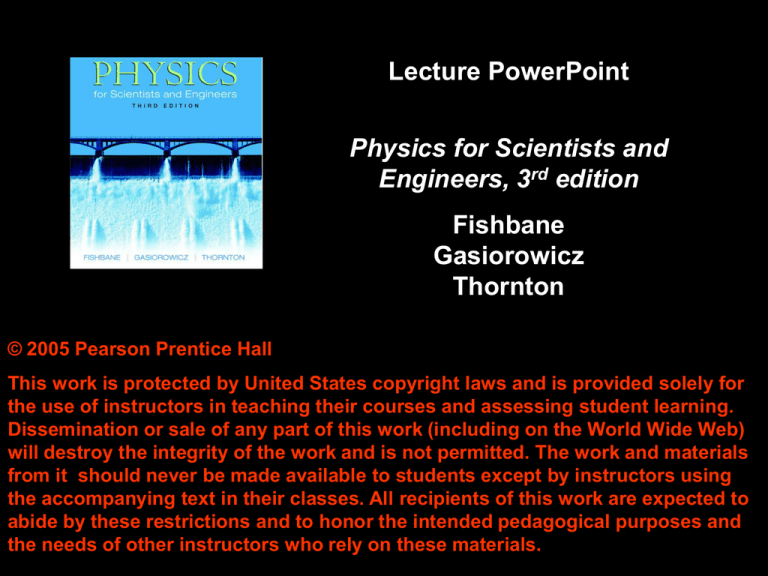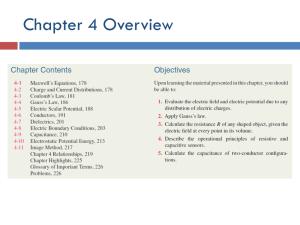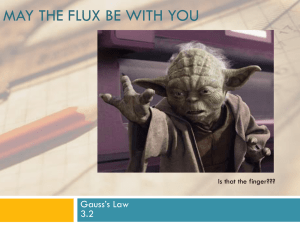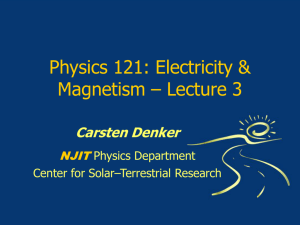
Lecture PowerPoint
Physics for Scientists and
Engineers, 3rd edition
Fishbane
Gasiorowicz
Thornton
© 2005 Pearson Prentice Hall
This work is protected by United States copyright laws and is provided solely for
the use of instructors in teaching their courses and assessing student learning.
Dissemination or sale of any part of this work (including on the World Wide Web)
will destroy the integrity of the work and is not permitted. The work and materials
from it should never be made available to students except by instructors using
the accompanying text in their classes. All recipients of this work are expected to
abide by these restrictions and to honor the intended pedagogical purposes and
the needs of other instructors who rely on these materials.
Chapter 23
Gauss’ Law
Main Points of Chapter 23
• Electric flux
• Gauss’ law
• Using Gauss’ law to determine electric fields
• Conductors and electric fields
• Testing Gauss’ and Coulomb’s laws
23-1 What Does Gauss’ Law Do?
Imagine field lines emanating from a
positive charge.
Now imagine a sphere of tissue paper
around the charge. How many field
lines penetrate the tissue? It doesn’t
really matter how many we draw in
the first place, as long as we are
consistent; they all go through.
Now imagine the charge being offcenter; all the lines still go through:
23-1 What Does Gauss’ Law Do?
Suppose the tissue is some shape other than
spherical, but still surrounds the charge.
All the field lines still go through:
Now, imagine the paper is crinkled
and overlaps itself; how shall we deal
with the lines that pierce the tissue
three times?
Notice that they go out twice and in
once – if we subtract the “ins” from
the “outs” we are left with one line
going out, which is consistent with
the other situations.
23-1 What Does Gauss’ Law Do?
Now, look at an open (flat) sheet.
If it is perpendicular to the field,
the maximum number of lines
penetrates:
If it is at an angle, fewer lines
penetrate:
23-1 What Does Gauss’ Law Do?
The number of field lines piercing the surface
is proportional to the surface area, the
orientation, and the field strength. If we stop
counting lines and just use the field strength
itself, we can define the electric flux through
an infinitesimal area:
Integrating gives the total flux:
(23-1)
23-1 What Does Gauss’ Law Do?
For a closed surface, we can uniquely define
the direction of the normal to the surface as
pointing outwards and define:
Then:
(23-3)
Note the circle on the integral sign, which means
that the integration is over a closed surface.
23-1 What Does Gauss’ Law Do?
Note that the surface does not have to be
made of real matter – it is a surface that we
can imagine, but that does not have to exist in
reality.
This kind of imaginary surface is called a
Gaussian surface. We can imagine it to be any
shape we want; it is very useful to choose one
that makes the problem you are trying to
solve as easy as possible.
23-2 Gauss’ Law
Without further ado, we can state Gauss’ law:
The electric flux through a closed surface
that encloses no net charge is zero.
23-2 Gauss’ Law
The electric flux through a
Gaussian sphere with a
single point charge at the
center is easily calculated,
as the field is known:
(23-4)
23-2 Gauss’ Law
But the result would be the same if the surface was
not spherical, or if the charge was anywhere inside
it!
Therefore, we can quickly generalize this to any
surface and any charge distribution; all can be
considered as a collection of point or infinitesimal
charges:
(23-5)
Here, Q is the total net charge enclosed by
the surface.
23-3 Using Gauss’ Law to Determine
Electric Fields
Problem-solving techniques:
1. Make a sketch.
2. Identify any symmetries.
3. Choose a Gaussian surface that matches the
symmetry – that is, the electric field is either
parallel to the surface or constant and
perpendicular to it.
4. The correct choice in 3 should allow you to get
the field outside the integral. Then solve.
23-4 Conductors and Electric Fields
In conductors, the charges are
free to move if there is an
external electric field exerting a
force on them.
• Therefore, in equilibrium, there
is no static field inside a
conductor. This also means that
the external electric field is
perpendicular to the conductor at
its surface.
23-4 Conductors and Electric Fields
What if the conductor is charged
– where does the excess charge
go?
• By making a Gaussian surface
very close to, but just under, the
surface of the conductor, we see
that any excess charge must lie
on the outside of the conductor.
23-4 Conductors and Electric Fields
What if there is a cavity inside the conductor, and
that cavity has charges in it?
The field inside the conductor must still be zero, so
charges will be induced on the inner surface of the
cavity and the outer surface of the conductor:
23-4 Conductors and Electric Fields
Electrostatic Fields Near Conductors
Looking at the electrostatic field very near a
conductor, we find:
and therefore:
(23-12)
The electric field is perpendicular to the
surface, and where the charge density is
higher, the field is larger.
23-4 Conductors and Electric Fields
To summarize:
1. The electrostatic field inside a conductor is zero.
2. The electrostatic field immediately outside a conductor
is perpendicular to the surface and has the value σ/ε0
where σ is the local surface charge density.
3. A conductor in electrostatic equilibrium—even one that
contains nonconducting cavities—can have charge only
on its outer surface, as long as the cavities contain no
net charge. If there is a net charge within the cavity,
then an equal and opposite charge will be distributed on
the surface of the conductor that surrounds the cavity.
23-5 Are Gauss’ and Coulomb’s
Laws Correct?
An experiment to validate Gauss’ law (that there
is no charge within a conductor) can be done as
follows:
Need a hollow conducing sphere, a small
conducting ball on an insulating rod, and an
electroscope attached to the surface of the
conductor.
23-5 Are Gauss’ and Coulomb’s
Laws Correct?
Charge the small sphere
and hold it inside the shell
without touching. Induced
charge will be on outside of
shell and on electroscope.
Now touch the inside of the
shell with the small sphere.
Charge will flow onto it until
it is neutral, leaving the
shell with a net positive
charge.
23-5 Are Gauss’ and Coulomb’s
Laws Correct?
Finally, remove the rod. The electroscope
leaves do not move, indicating that the
excess charge resides on the outside of the
shell.
23-5 Are Gauss’ and Coulomb’s
Laws Correct?
This table shows the results of such
experiments looking for a deviation
from an inverse-square law:
23-5 Are Gauss’ and Coulomb’s
Laws Correct?
One problem with the above experiments is that they
have all been done at short range, 1 meter or so.
Other experiments, more sensitive to cosmic-scale
distances, have been done, testing whether
Coulomb’s law has the form:
No evidence for a nonzero μ has been found.
Summary of Chapter 23
• Electric flux due to field intersecting a surface S:
(23-1)
• Gauss’ law relates flux through a closed surface
to charge enclosed:
(23-5)
• Can use Gauss’ law to find electric field in
situations with a high degree of symmetry
Summary of Chapter 23, cont.
• Properties of conductors:
1. Electric field is zero inside
2. Field just outside conductor is perpendicular
to surface
3. Excess charge resides on the outside of a
conductor, unless there is a nonconducting
cavity in it; in that case, there is an induced
charge on both surfaces
• Gauss’ law has been verified to a very high
degree of accuracy








